
During the summer of 1997 I didn’t know what bird-babies Dale Thompson would show up with next for me to hand feed. It was always a big surprise to have him drive up, fling the truck door open and let me have the first look into all the little cardboard boxes he put the babies in for their trip to my house. Gingerly carrying the boxes upstairs, I would carefully peek in each one of them. I was always eager to see what wee squirming wonders nestled in wood shavings he was bringing me. For a baby-bird lover such as I am, it was like Christmas every time he arrived with babies in tow!
That year saw a lot of baby bird species cross my door- step from Dale, but he consistently brought Hoffman’s conures every trip. Some were feathered, some were week old tiny little bumble-bee size and the middle sized ones looked like Eskimos with fluffy down snow-suits on. He would take them from the nest and head directly for my house. Some ate pretty well after the three-hour trip, but most took about 24 hours to develop an enthusiastic feeding response. From then on they were truly the ‘eager eaters’ among the baby population here.
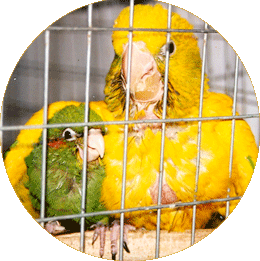
They grew like little weeds and weaned very quickly at 50 to 60 days. Even though Dale warned me not to socialize them, it was too much of a temptation to cuddle and scratch their heads. All the time I thought, boy would they ever make terrific pets. Cute as a button and inquisitive, they followed me around the house flying after me to use my head or shoulder as a landing destination. They are much quieter than some of the other conures!
They also made very exotic, expensive bed-warmers for a hen vosmaeri Eclectus I was hand feeding at the time too. Because I hate seeing a baby all alone in her Tupperware-bassinet, I put a couple of Hoffman’s in with the Eclectus. I chose two Hoffman’s that were almost the size of the Eclectus for safety reasons. They matured a lot faster than the Eclectus so in a couple of weeks I selected two more that were smaller and switched. The hen Eclectus went through three sets of Hoffman bed-mates before she was feathered. Babies that age don’t realize they are from different continents and species. They just know it is darn good to have a buddy to cuddle up to! The last odd-mix trio lived harmoniously, eating, playing and snuggling together for over a month until the Eclectus girl was adopted.
The months flew by and I would periodically trade Dale fully weaned Hoffman’s conures for still another clutch of tiny ones. By fall he informed me I had weaned 26 Hoffman’s that season. Truly a delightful, animated little green creature that I had lots of fun with during my “Summer of the Little Green Men!”
In a recent interview with Dale Thompson, he gave me the background of his experience with the Hoffman’s conure, since they have been in this country.
The Hoffman’s conure is one of the Pyrrhura conures found in Central America. It originates in the very north-western part of Panama and the Southern part of Costa Rica. This species has never been found legally in captivity, mainly because Costa Rica does not allow export of its natural wildlife. Panama however allowed its natural wildlife to be exported before 1980.

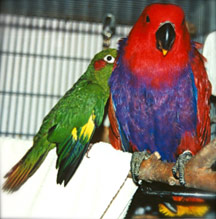 In 1980, Dr. Nathan B. Gale, was chief Veterinarian in the Panama Canal Zone. This was a private sector, and they actually worked with the army. Dr. Gale was instrumental in sending thirty -six specimens of the Hoffman’s conure to the U.S. through a regular USDA approved quarantine station. This was the only group that has ever entered the US, let alone, the rest of the world.
In 1980, Dr. Nathan B. Gale, was chief Veterinarian in the Panama Canal Zone. This was a private sector, and they actually worked with the army. Dr. Gale was instrumental in sending thirty -six specimens of the Hoffman’s conure to the U.S. through a regular USDA approved quarantine station. This was the only group that has ever entered the US, let alone, the rest of the world.
After the export ban in 1980, the only way any birds could be exported out of Panama was if export permits were acquired within Panama prior to the ban. A permit was needed from R.E.N.A.R.I., which is an equivalent to our US Fish and Wildlife. This was especially important for any military personnel serving their term in Panama. They had to have this permit prior to leaving. Many people at the military base had conures, macaws and especially the Panama Amazon in their homes. If they obtained this permit they could later export their pet bird legally after 1980. You had to have a permit or you would not be able to take your pet home with you. For all commercial shipments, however, the export ban of 1980 eliminated that possibility.
In March of 1980, thirty- six Hoffman conures were exported out of Panama, from Nathan B. Gale to a large USDA approved quarantine station owned by Gerald Schulman. Upon their release, these birds were distributed among three aviculturists. One had a single pair and the others were divided between two aviculturists in Arizona. It was during this status in 1982 that a first breeding was achieved in this species. This accomplishment was achieved by Chris Rowley, an aviculturist living in Arizona.
After about a decade the interest in the Hoffman’s among the aviculturists had died down. By 1992, the original population of 36 had been reduced to a total of 11 specimens. All 11 birds were removed and shipped to Dale Thompson in California.
The birds were all shipped in one container and there weren’t any records. Not much was known about them except for bands, which showed which were wild caught, (the founder stock) and which were the captive-bred youngsters. There was a known reproducing pair within this group. It was decided that all of these 11 birds should be sexed by endoscopy. By doing this , we would know for sure what we were working with. The results turned out to be seven males and four females.
After they had been laproscoped all of the birds were all placed together within a big flight. We had hopes that we could observe the breeding pair quickly by their behavior. As it was, it took only three days to observe which was the “good” pair as they show a very close bond by always perching next to each other. This breeding pair was then removed from the main group and we watched for further bonding among the remaining nine birds. An additional pair was observed showing close bonding and a second pair showed a loose-formed bond. From this limited beginning, we decide to form a Hoffman’s Conure Breeding Consortium. During the first year we were just trying to get reproduction from any of the pairs because our total numbers had been drastically reduced. We realized that with 11 total birds we knew the value of acquiring as much genetic diversity within the offspring. That first year, however, we just needed numbers; so we reproduced as many offspring from the formed pairs as we could get.
There were five original members in the breeding consortium. As irony would have it, one of the pairs took off and bred most of the youngsters. This was the very first pair that had been removed form the group.

Inbreeding is done in aviculture for certain reasons mainly to exaggerate certain traits within a species. One example is to produce and maintain a certain song within roller canaries or to line-breed offspring to acquire consistent form, color or size. This is done to a great extent with cockatiels to acquire a new mutation or to maintain or improve a mutation color.
When it comes to reproducing rare birds, the opposite approach must be taken. Utmost care must be taken to avoid inbreeding. As any population becomes more inbred, the offspring tends to become less infertile and many physical abnormalities begin to show up. When birds found in the wild or in captivity are in great numbers, there is a large genetic diversity within that population. Genetic diversity insures that a species will survive when any environmental conditions occur (hurricanes, etc.) or when medical disasters occur. This last is especially serious within rare captive populations.
Within aviculture, we must choose the responsible route when it comes to the breeding practices within rare or endangered species. In the wild and certainly now in captive breeding, when there is a small genetic diversity within the population due to a low numbers of birds, there is a greater risk of extinction within that species. This is due to the fact that there is a poor chance for that population containing so few individuals to survive a medical, environmental or even a poor breeding season.
The challenge to surmount these problems is to determine how to improve the genetic diversity within a species that contains very small numbers. To accomplish this task, I began communicating with Dr. Phil Ryan, and Graeme Phipps from Australia, two very good practical genetic experts. The concept for acquiring a large genetic diversity within the offspring is to reproduce all individual birds of one sex to all of the birds of the opposite sex. A minimum number needed for good genetic diversity of any species held in captivity is six unrelated pairs. The concept being that all six pair would reproduce. Let us use an example of two unrelated pairs of birds (Male A, Female B, Male C, Female D) the breeder has the choice of reproducing them in only two combinations to keep all of the lines pure (representing each combination of parent bloodlines. This would be from breeding A x B, C x D or A x D and C X B.
The best way to keep maximum genetic diversity within a captive population is to continually breed unrelated stock with each other. When this is impossible due to the lack of numbers, it is then important to reproduce every bird with every combination of mating. If it were possible to reproduce the six pairs of birds, for every possible combination, there would be six possible combinations for the first male: (A x B, A x D, A x F, A x H, A x J, A x L, etc.). The results of this kind of reproduction is that all offspring somewhere down the line would eventually have a combination of every founder stock member’s genetic material thus creating a “Maximum Genetic Diversity” population within the species. This way all of the good genetic material would be maximized while greatly reducing any negative genetic material such as physical abnormalities or mutations. This is the opposite of inbreeding and our consortium’s goal was to keep away from any physical abnormalities or mutations. Toe, leg, and eye abnormalities, along with color changes, are a few of the early problems first occurring within birds that are line-bred or inbred consistently.
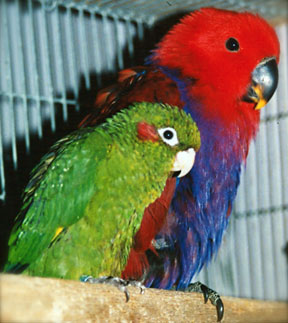

Within the Hoffman’s Conure Consortium, we had seven males and only four females. The best combination would that every one of the four females would successfully reproduce with every one of the seven males. One of the biggest problems facing the consortium was that two of the founder males were in captivity for sixteen years and they were acquired as adult birds. It was very likely that these old birds would not breed as they were well past the ability to reproduce successfully.
After successfully reproducing the first excellent breeding pair, the female was then paired with other males. The first change in mates was with one of the old 16-year plus males. This ‘B’ female did reproduce one year with this old male but he died of old age the following winter. The other ancient male was paired with every female over a period of four breeding seasons and every single egg laid was infertile. The genetic material so needed from this male was never utilized within the group of Hoffman’s conures.
We decided to parent-rear as many of the birds as possible after the first year. The first year we hand fed and the second year we parent reared from then on. Unless we had a problem baby, which was very minimal, we allowed the parents to raise their own babies. By doing this, we did not have double or triple clutching that often occurs with breeders of Pyrrhura conures when they hand rear all the youngsters. Most of our early clutches contained only two to three eggs. They were very few three- and four-egg clutches. Pyrrhura are noted to have 6, 7 and 8 eggs….large clutches. We never achieved these numbers with the Hoffman’s conures.
All offspring were held back for future breeding and mates were chosen for each pairing to follow the above formula to maintain long-term genetic diversity. The early going was very difficult for several reasons. With the adult birds, we moved each reproducing female over one step to another male. Bonded birds often are reluctant to reproduce with another mate immediately. Two of the founder females reproduced very well, the first being exceptional. The third and fourth females did reproduce but they often waited two years to reproduce and several times they were reluctant of be good parents bringing off only one offspring.
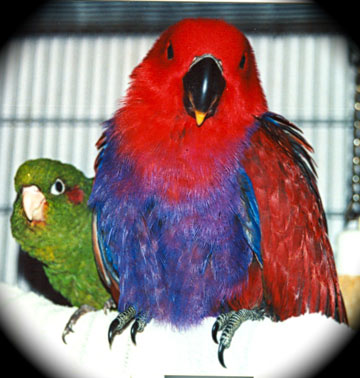
The second problem was the ratio of produced offspring. The first two years produced 14 males and 3 females. This was a very lop-sided ratio. We had to set aside so many of the early males as reproducing them would have caused inbreeding problems we were trying to stay away from. Production started very low, as we didn’t have as many females as we needed. The ration of female to male offspring during the third and fourth year’s production increased greatly. The fourth generation offspring was the first time that we produced more females that we did males even if it was by one individual. By 1998 all of the founder stock had died.
Our pairs, after four years, were now beginning to reproduce twos and threes and four-egg clutches and the babies were consistently bigger in size and weight. We also were increasing our number of clutches each pair was rearing per year. Our average clutch sizes were increasing or at least becoming uniform. We were delighted that we were acquiring a larger baby than we were producing during the original 1993 hatch.
During the early formidable years, we followed closely the genetic formula formulated by the consortium. It was during the fifth year that we decided to feed the original males into the equation. These were 14 males from the original ‘good’ breeding female that had never been used for breeding. These birds were four generations down and we were informed by consulting geneticists that after this many generations, this would not increase the negativity of inbreeding. What we were NOT looking for was mutations. That was one thing we did not want, because we would then be dealing with inbred birds. We took these four- and five-year old males and paired them with one-year old females. The consortium had decided to not reproduce young stock prior to 18 months of age. We did not want females having problems with their reproductive systems. They needed to be fully developed, because it is too easy to get in a big hurry like the mistakes that are made with lovebirds and cockatiels in breeding them at six to nine months of age. If we failed, the loss would be great with birds this valuable in aviculture. By the fifth year, the youngsters were laying eggs in their feed dishes at 12 months of age, so we decided to give the young pairs their nest boxes earlier that previously done.
These four to five-year old males turned out to be very good breeders. They had excellent fertile clutches and were the consistently the best parents of any of the pairs within the consortium. We believe this was due to their maturity and being mostly parent-reared. They were also housed together during the previous years in a very large flight and were very socialized.
By 1997 our production evened out, sex-wise. The following year the consortium actually had four extra females. The genetic diversity of sexes had evened out and we believe this will be for the long term. When selling the first offspring, we had decided that each shipment would consist of a minimum of three pair. This would assist in keeping their genetic diversity strong. We never shipped a single pair, as this would defeat the purpose. We actually informed every buyer which male would go with what female. The birds were all banded and sent to seven countries overseas. These youngsters reproduced extraordinarily well overseas and by 1998 we saw these pairs starting to flood the foreign market. They had found their way into the commercial market overseas (not meaning commercial as the pet market) and they were being sold to breeders as single pairs instead of staying to the three to four pair formula.
The concept of the breeding consortium was that Dale Thompson, being the consortium director, would receive all the babies of all the Hoffman’s conures. The producing pairs always went to the other consortium members. The reason being, if you send young birds to consortium members, they could easily get tired of keeping these young birds waiting for them to breed, (especially if they waited two or three years and were getting no results in their breeding program). Breeders feel so excited and their interest is kept very high with successful pairs. They kept the same pairs, but occasionally the following year, pairs would be switched. They would always get to keep the very good breeding pairs. Obviously all the babies were sent back to the home of the breeding director. Then the babies could be matched up and sent out as new pairs after that. It worked out well and was an incredibly good concept to keep the whole thing going and keep the interest up. By1999 there were over 350 total babies;total of birds that had been reared worldwide!
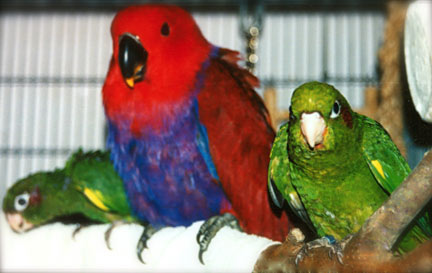

There are two sub species listed in the books on Hoffman’s conure. The nominate race is Pyrrhura hoffmanni hoffmanni. The second subspecies is Pyrrhura hoffmanni gaudens.
The alternative common name for this species is sulfur-winged conure, parakeet or parrot. Many Europeans use the term sulfur-winged parrot. They also used to be known as the red-eared conure, but that term is also used with another Pyrrhura and the use of that term has been dropped for Hoffman’s.
The Hoffman’s conure main plumage is green with large, deep red patches over the ear-coverts on both sides of the head. Bright sulfur-yellow coloration is present on the upper side of the inner primary feathers and the outer secondaries. The underside of the flight feathers is a duller yellow color. Some yellow tipping is present in the green plumage of the head and the throat. The over all length of the Hoffman’s is approximately 24 cm (9.6 inches) and weighs about 84 grams (2.94 to 3.12 ounces).
Of the two recognized subspecies, the differences are slight. The natural range of the Hoffman’s conure is divided into two areas. The nominate subspecies, hoffmanni, originates from southern Costa Rica, while the sub species gaudens originates from western Panama. Differences between the sub species are slight, but easily detected upon close examination. The nominate subspecies differs by having less yellow marking over the head and the green plumage over the lower part of the body is of a lighter shade.
The gaudens has a reddish tinge to the insides of all the feathers on the top and back of the head down to the nape. Of the birds from the original group that came in, some seemed to have a few flecks of red on the back of their heads but most were of the nominate race. When the wing of the gaudens is stretched out, you can see a beautiful yellow on the secondary feathers of their wings.
As we were reproducing this bird into the fifth year we had a number of birds that were showing intense color of the babies. This coloration was not only just in the red of their heads but the dramatic intensity of having full yellow wings. They were remarkably different and we were then realizing that this was the subspecies surfacing now, by genetic diversity. Even though we were trying to keep it apart as much as possible, this sub species was showing up. After about the sixth year we felt we had enough genetic diversity in our group that we could isolate and reproduce the gaudens subspecies by themselves. It was a very nice bird with good intensity of both reds and yellows and even some of the greenish-yellow on the wings. On some there was a full yellow slash on its wing. Really a beautiful subspecies, the gaudens!

Because this information was important to me, I sat down with Dale Thompson and had him relate the incredible history and success of the Hoffman’s conure to me. I hope his valuable information will help aviculturists and folks involved in starting and maintaining breeding consortiums too. Looking back, I feel very privileged that Dale trusted me to hand feed and rear his valuable little green feather-gems. They were sure cute little ‘cusses’, and I hope to see enough of them raised in captivity so that someday we can see them as the lovely little pets that I KNOW they have the potential to be! I know Dale would be horrified to hear me say this about his pride and joy but here’s hoping he never reads my conclusion!!!!!

